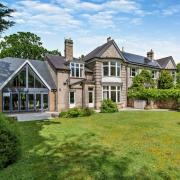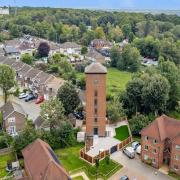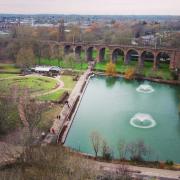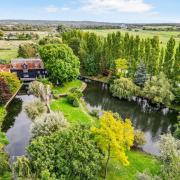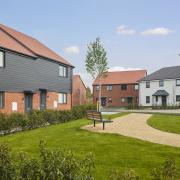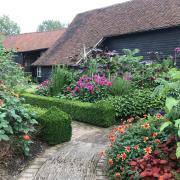An idyllic spot, just a 20-minute walk from Colchester town centre, is where a forward-thinking and ambitious group of friends chose to create a cohousing community. They identified the site back in 2012 and today the eco-village consists of private Passivhaus homes of varying size, some with private balconies and small gardens, and Cannock Mill House, which has been converted into a number of flats. All enjoy a large communal outdoor space. The main drivers for the project were to have energy-efficient homes surrounded by wildlife where a group of friends could enjoy living together.
The original members of the group were able to move in at the end of 2019. While their homes were finished to the internationally recognised Passivhaus Standard with efficient insulation and a mechanical ventilation system providing high levels of heat recovery, the grounds were still a thing of potential. In fact, where there had previously been fields there was now only mud, a slope down to the houses the only indication of any future gardens.

CREATING A NATURAL AND SUSTAINABLE ENVIRONMENT
To understand the site it's as well to start at the large mill pond. This is overlooked by the Grade ll listed Cannock Mill, which is now known as the Common House. 'The land around the mill pond needed to work as the group’s outside meeting space,' says Lesley Scordellis, who joined the group four years before they were able to move in, 'and so we thought carefully where decking and seating areas should be positioned to provide space needed for socialising and also for enjoying the wildlife drawn to the water'.
With the soil largely a mix of clay, gravel and natural springs, the land around the mill pond needed to have drainage installed as a pre-contract. The houses replicate the way the site absorbed rainwater before they were built, using the road and roof surfaces to do so. 'We were determined that no run-off should go into the main drains. The landscape architects working with the architects designed a Sustainable Drainage System (SuDS). We have deep green roofs on the houses to manage the water flow by slowing its progress and providing areas for storage where it can dissipate slowly. The water comes out of the rainwater pipes and goes straight onto the porous road surface, then filters through the road surface into a lined ‘tank’ full of stones. Water then flows into the ‘rain gardens’ around the edge of the mill pond. These are planted with a mix of phlomis, iris and vinca, which can withstand both wet and dry conditions.'
Some native trees have been planted but the wider areas of outdoor space have been kept as grassland. 'The whole site feels very rural,' says Lesley. 'It was a given that the majority of the outdoor space would remain as natural as possible to attract wildlife but we have introduced wild flowers such as cowslips, forget-me-nots and species bulbs with a strict no-mow May - except for paths - policy in place.”

While the site is close to Colchester City centre it is surrounded by trees and wildlife thanks to its position next to Bourne Valley, a woodland and wetland site covering some 15 acres. 'We have to put up with the muntjac deer but that is a small price to pay for being where we are!'
This does not mean that there are no cultivated areas, however. Lockdown in March 2020, shortly after the first people moved in, provided the time to focus the new residents’ energies onto various projects. 'We have a community work day every eight days,' says Lesley. 'This means that we can work through a list of jobs that need doing, such as pulling reeds out of the pond and general planting and weeding. We also have a garden group, which suggests ideas and projects that will benefit the whole community.'
Ideas so far have included a large vegetable plot of 12 raised beds from which fruit and vegetables are produced to be shared among everyone. Another area for planting flowers is an ongoing project and a bog garden is in its early stages. Tucked away, there is an area for composting bins, a shed and wood store.' Maintaining the grounds has become part of the "ongoing projects" list, in which we can participate as much as we wish.'

Some of the homes have south-facing gardens to the rear, providing private spaces as well as some shared growing spaces. Naturally they came with a challenge and this time it was the north-facing slope of the land running down towards the buildings. It was necessary to have this area professionally terraced, but this was not completed immediately so the resulting gardens are still quite new and the planting is developing. However, the results are already remarkable.' The gardens tend to morph into one another,' explains Lesley. ' They each have their own planting schemes but the result, when walking along the path above them, is of one glorious, mass of colour, humming with bees and insects.'
Because the gardens receive so much sun there is the potential to grow a wide range of interesting annuals and perennials. The community bee hives are nearby to assist with pollination and provide honey. Most of the homes have private balconies and these, too, are full of colour, enjoying the same south-facing aspect.
This year the community has decided to open their unusual gardens to the public through the National Garden Scheme charity. This is not the first open day they will have hosted - the idea of joining in with various schemes gives them the opportunity to introduce the idea of cohousing to as many people as possible. The National Garden Scheme resonates particularly with the residents of Cannock Mill, not only because so many of them are keen gardeners but also because of the charity's health and nursing beneficiaries - many residents have lost good friends to cancer over the years.

The County Organiser for the National Garden Scheme in Essex, Susan Copeland, has been delighted to welcome Cannock Mill Cohousing into the Scheme. 'We have been expanding our repertoire of gardens over the last few years,' she says.' While there are still many large country gardens that open for us along with smaller town gardens and allotments we are finding that our visitors are increasingly interested in different sorts of gardens. So, we have welcomed wild flower gardens and those that focus on using reclaimed materials. Community gardens are a growing area of interest. Not only does the National Garden Scheme help community garden projects with funding, but also by then encouraging them to open to the public. This gives the opportunity for further benefit from sharing the results with admiring visitors. Sharing what you have created definitely helps the communities to thrive'.
A visit to Cannock Mill Cohousing will only reinforce this thought. The way that the residents share their knowledge and skills clearly brings huge benefits in terms of results. But the additional positives of being outside, working together and sharing the produce should not be overlooked. Cannock Mill today is surely vindication of the original group’s vision and determination.
ngs.org.uk
cannockmillcohousing.co.uk





